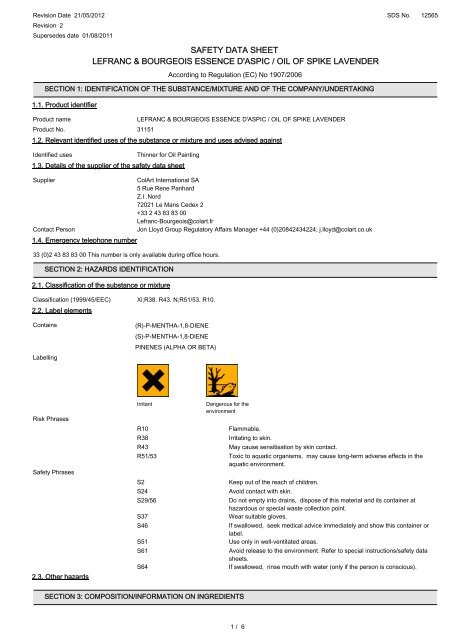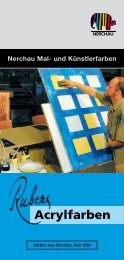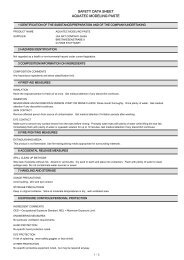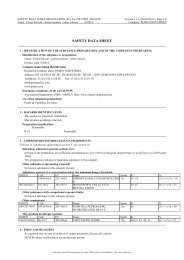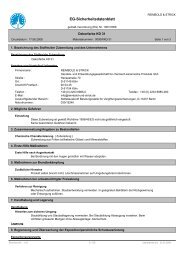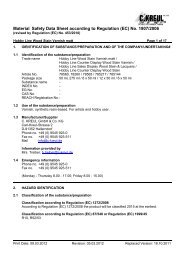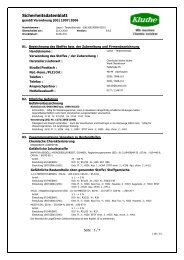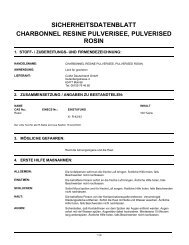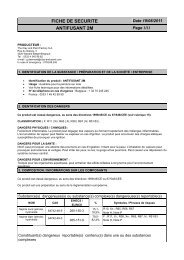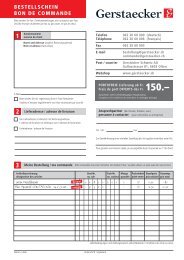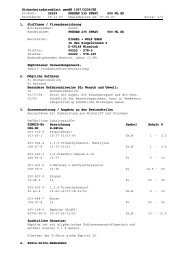safety data sheet lefranc & bourgeois essence d'aspic ... - Kreativ.de
safety data sheet lefranc & bourgeois essence d'aspic ... - Kreativ.de
safety data sheet lefranc & bourgeois essence d'aspic ... - Kreativ.de
Create successful ePaper yourself
Turn your PDF publications into a flip-book with our unique Google optimized e-Paper software.
Revision Date 21/05/2012<br />
Revision 2<br />
Superse<strong>de</strong>s date 01/08/2011<br />
SDS No. 12565<br />
SAFETY DATA SHEET<br />
LEFRANC & BOURGEOIS ESSENCE D'ASPIC / OIL OF SPIKE LAVENDER<br />
According to Regulation (EC) No 1907/2006<br />
SECTION 1: IDENTIFICATION OF THE SUBSTANCE/MIXTURE AND OF THE COMPANY/UNDERTAKING<br />
1.1. Product i<strong>de</strong>ntifier<br />
Product name<br />
Product No. 31151<br />
LEFRANC & BOURGEOIS ESSENCE D'ASPIC / OIL OF SPIKE LAVENDER<br />
1.2. Relevant i<strong>de</strong>ntified uses of the substance or mixture and uses advised against<br />
I<strong>de</strong>ntified uses<br />
Thinner for Oil Painting<br />
1.3. Details of the supplier of the <strong>safety</strong> <strong>data</strong> <strong>sheet</strong><br />
Supplier<br />
Contact Person<br />
1.4. Emergency telephone number<br />
33 (0)2 43 83 83 00 This number is only available during office hours.<br />
SECTION 2: HAZARDS IDENTIFICATION<br />
2.1. Classification of the substance or mixture<br />
Classification (1999/45/EEC) Xi;R38. R43. N;R51/53. R10.<br />
2.2. Label elements<br />
ColArt International SA<br />
5 Rue Rene Panhard<br />
Z.I .Nord<br />
72021 Le Mans Ce<strong>de</strong>x 2<br />
+33 2 43 83 83 00<br />
Lefranc-Bourgeois@colart.fr<br />
Jon Lloyd Group Regulatory Affairs Manager +44 (0)20842434224; j.lloyd@colart.co.uk<br />
Contains<br />
Labelling<br />
(R)-P-MENTHA-1,8-DIENE<br />
(S)-P-MENTHA-1,8-DIENE<br />
PINENES (ALPHA OR BETA)<br />
Risk Phrases<br />
Safety Phrases<br />
2.3. Other hazards<br />
Irritant<br />
R10<br />
R38<br />
R43<br />
Dangerous for the<br />
environment<br />
Flammable.<br />
Irritating to skin.<br />
May cause sensitisation by skin contact.<br />
R51/53 Toxic to aquatic organisms, may cause long-term adverse effects in the<br />
aquatic environment.<br />
S2<br />
S24<br />
Keep out of the reach of children.<br />
Avoid contact with skin.<br />
S29/56 Do not empty into drains, dispose of this material and its container at<br />
hazardous or special waste collection point.<br />
S37<br />
Wear suitable gloves.<br />
S46<br />
S51<br />
S61<br />
S64<br />
If swallowed, seek medical advice immediately and show this container or<br />
label.<br />
Use only in well-ventilated areas.<br />
Avoid release to the environment. Refer to special instructions/<strong>safety</strong> <strong>data</strong><br />
<strong>sheet</strong>s.<br />
If swallowed, rinse mouth with water (only if the person is conscious).<br />
SECTION 3: COMPOSITION/INFORMATION ON INGREDIENTS<br />
1 / 6
3.2. Mixtures<br />
LEFRANC & BOURGEOIS ESSENCE D'ASPIC / OIL OF SPIKE LAVENDER<br />
SDS No. 12565<br />
(R)-P-MENTHA-1,8-DIENE 5-10%<br />
CAS-No.: 5989-27-5 EC No.: 227-813-5<br />
Classification (EC 1272/2008)<br />
Flam. Liq. 3 - H226<br />
Skin Irrit. 2 - H315<br />
Skin Sens. 1 - H317<br />
Aquatic Acute 1 - H400<br />
Aquatic Chronic 1 - H410<br />
Classification (67/548/EEC)<br />
Xi;R38.<br />
N;R50/53.<br />
R10,R43.<br />
(S)-P-MENTHA-1,8-DIENE 1-5%<br />
CAS-No.: 5989-54-8 EC No.: 227-815-6<br />
Classification (EC 1272/2008)<br />
Flam. Liq. 3 - H226<br />
Skin Irrit. 2 - H315<br />
Skin Sens. 1 - H317<br />
Aquatic Acute 1 - H400<br />
Aquatic Chronic 1 - H410<br />
Classification (67/548/EEC)<br />
Xi;R38.<br />
N;R50/53.<br />
R10,R43.<br />
LINALOOL 30-60%<br />
CAS-No.: 78-70-6 EC No.: 201-134-4<br />
Classification (EC 1272/2008)<br />
Skin Irrit. 2 - H315<br />
Classification (67/548/EEC)<br />
Xi;R38.<br />
PINENES (ALPHA OR BETA) 5-10%<br />
CAS-No.:<br />
EC No.:<br />
Classification (EC 1272/2008)<br />
Flam. Liq. 3 - H226<br />
Skin Sens. 1 - H317<br />
Asp. Tox. 1 - H304<br />
Aquatic Acute 1 - H400<br />
Aquatic Chronic 1 - H410<br />
Classification (67/548/EEC)<br />
Xn;R65.<br />
N;R50/53.<br />
R10,R43.<br />
The Full Text for all R-Phrases and Hazard Statements are Displayed in Section 16.<br />
SECTION 4: FIRST AID MEASURES<br />
4.1. Description of first aid measures<br />
General information<br />
Consult a physician for specific advice.<br />
Inhalation<br />
Move the exposed person to fresh air at once. Keep the affected person warm and at rest. Get prompt medical attention.<br />
Ingestion<br />
NEVER MAKE AN UNCONSCIOUS PERSON VOMIT OR DRINK FLUIDS! Immediately rinse mouth and provi<strong>de</strong> fresh air. DO NOT induce<br />
vomiting. Get medical attention immediately.<br />
Skin contact<br />
Remove affected person from source of contamination. Promptly wash contaminated skin with water. Promptly remove clothing if soaked<br />
through and wash the skin with water.<br />
Eye contact<br />
Promptly wash eyes with plenty of water while lifting the eye lids. Continue to rinse for at least 15 minutes and get medical attention.<br />
2 / 6
LEFRANC & BOURGEOIS ESSENCE D'ASPIC / OIL OF SPIKE LAVENDER<br />
4.2. Most important symptoms and effects, both acute and <strong>de</strong>layed<br />
SDS No. 12565<br />
4.3. Indication of any immediate medical attention and special treatment nee<strong>de</strong>d<br />
SECTION 5: FIREFIGHTING MEASURES<br />
5.1. Extinguishing media<br />
Extinguishing media<br />
Extinguish with carbon dioxi<strong>de</strong> or dry pow<strong>de</strong>r. Do not use water as an extinguisher.<br />
Unsuitable extinguishing media<br />
DO NOT use water if avoidable.<br />
5.2. Special hazards arising from the substance or mixture<br />
Unusual Fire & Explosion Hazards<br />
No unusual fire or explosion hazards noted.<br />
5.3. Advice for firefighters<br />
Special Fire Fighting Procedures<br />
Avoid breathing fire vapours. Water spray should be used to cool containers.<br />
Protective equipment for fire-fighters<br />
Selection of respiratory protection for fire fighting: follow the general fire precautions indicated in the workplace.<br />
SECTION 6: ACCIDENTAL RELEASE MEASURES<br />
6.1. Personal precautions, protective equipment and emergency procedures<br />
Wear protective clothing as <strong>de</strong>scribed in Section 8 of this <strong>safety</strong> <strong>data</strong> <strong>sheet</strong>. Avoid inhalation of vapours and contact with skin and eyes.<br />
Provi<strong>de</strong> a<strong>de</strong>quate ventilation.<br />
6.2. Environmental precautions<br />
Contain spillages with sand, earth or any suitable adsorbent material. Do not allow to enter drains, sewers or watercourses. Collect and<br />
dispose of spillage as indicated in section 13.<br />
6.3. Methods and material for containment and cleaning up<br />
Ventilate well. Absorb small quantities with paper towels and evaporate in safe place (fume hood). Allow sufficient time for vapours to<br />
completely clear the hood ducts, then burn the paper in a location away from combustible materials. Absorb in vermiculite, dry sand or earth<br />
and place into containers.<br />
6.4. Reference to other sections<br />
SECTION 7: HANDLING AND STORAGE<br />
7.1. Precautions for safe handling<br />
Keep away from heat, sparks and open flame. Avoid spilling, skin and eye contact. Ventilate well, avoid breathing vapours. Use approved<br />
respirator if air contamination is above accepted level.<br />
7.2. Conditions for safe storage, including any incompatibilities<br />
Flammable/combustible - Keep away from oxidisers, heat and flames. Store in tightly closed original container in a dry, cool and well-ventilated<br />
place. Protect from light, including direct sunrays.<br />
Storage Class<br />
Chemical storage. Flammable liquid storage.<br />
7.3. Specific end use(s)<br />
SECTION 8: EXPOSURE CONTROLS/PERSONAL PROTECTION<br />
8.1. Control parameters<br />
8.2. Exposure controls<br />
Protective equipment<br />
3 / 6
Process conditions<br />
LEFRANC & BOURGEOIS ESSENCE D'ASPIC / OIL OF SPIKE LAVENDER<br />
Provi<strong>de</strong> eyewash station. Use engineering controls to reduce air contamination to permissible exposure level.<br />
Engineering measures<br />
Provi<strong>de</strong> a<strong>de</strong>quate ventilation, including appropriate local extraction, to ensure that the <strong>de</strong>fined occupational exposure limit is not excee<strong>de</strong>d.<br />
Respiratory equipment<br />
If ventilation is insufficient, suitable respiratory protection must be provi<strong>de</strong>d.<br />
Hand protection<br />
For prolonged or repeated skin contact use suitable protective gloves. Nitrile gloves are recommen<strong>de</strong>d.<br />
Eye protection<br />
Use eye protection.<br />
Hygiene measures<br />
SDS No. 12565<br />
Use appropriate skin cream to prevent drying of skin. Promptly remove non-impervious clothing that becomes wet or contaminated. No specific<br />
hygiene procedures noted, but good personal hygiene practices are always advisable, especially when working with chemicals.<br />
SECTION 9: PHYSICAL AND CHEMICAL PROPERTIES<br />
9.1. Information on basic physical and chemical properties<br />
Appearance<br />
Liquid<br />
Colour<br />
Light (or pale).<br />
Odour<br />
Characteristic.<br />
Solubility<br />
Insoluble in water<br />
Relative <strong>de</strong>nsity 0, 880-0, 905<br />
Vapour pressure<br />
175-300 kPa<br />
Flash point<br />
51 CC (Closed cup).<br />
9.2. Other information<br />
SECTION 10: STABILITY AND REACTIVITY<br />
10.1. Reactivity<br />
10.2. Chemical stability<br />
10.3. Possibility of hazardous reactions<br />
10.4. Conditions to avoid<br />
10.5. Incompatible materials<br />
10.6. Hazardous <strong>de</strong>composition products<br />
During fire, toxic gases (CO, CO2, NOx) are formed.<br />
SECTION 11: TOXICOLOGICAL INFORMATION<br />
11.1. Information on toxicological effects<br />
Toxicological information<br />
No information available.<br />
General information<br />
Contains small amounts of organic solvents. Extensive use of the product in areas with ina<strong>de</strong>quate ventilation may result in hazardous vapour<br />
concentrations.<br />
Inhalation<br />
May cause irritation to the respiratory system. Vapours may cause headache, fatigue, dizziness and nausea.<br />
Skin contact<br />
Product has a <strong>de</strong>fatting effect on skin. Prolonged contact may cause redness, irritation and dry skin.<br />
Eye contact<br />
May cause temporary eye irritation.<br />
SECTION 12: ECOLOGICAL INFORMATION<br />
4 / 6
Ecotoxicity<br />
LEFRANC & BOURGEOIS ESSENCE D'ASPIC / OIL OF SPIKE LAVENDER<br />
Dangerous for the environment: May cause long-term adverse effects in the aquatic environment.<br />
SDS No. 12565<br />
12.1. Toxicity<br />
12.2. Persistence and <strong>de</strong>gradability<br />
12.3. Bioaccumulative potential<br />
12.4. Mobility in soil<br />
12.5. Results of PBT and vPvB assessment<br />
12.6. Other adverse effects<br />
SECTION 13: DISPOSAL CONSIDERATIONS<br />
13.1. Waste treatment methods<br />
Do not allow runoff to sewer, waterway or ground. Dispose of waste and residues in accordance with local authority requirements.<br />
SECTION 14: TRANSPORT INFORMATION<br />
14.1. UN number<br />
UN No. (ADR/RID/ADN) 1169<br />
UN No. (IMDG) 1169<br />
UN No. (ICAO) 1169<br />
14.2. UN proper shipping name<br />
Proper Shipping Name<br />
Proper Shipping Name<br />
AROMATIC LIQUID EXTRACTS<br />
AROMATIC LIQUID EXTRACTS<br />
14.3. Transport hazard class(es)<br />
ADR/RID/ADN Class 3<br />
ADR/RID/ADN Class<br />
Class 3: Flammable liquids.<br />
IMDG Class 3<br />
ICAO Class/Division 3<br />
Transport Labels<br />
FLAMMABLE<br />
LIQUID<br />
3<br />
14.4. Packing group<br />
ADR/RID/ADN Packing group<br />
IMDG Packing group<br />
ICAO Packing group<br />
III<br />
III<br />
III<br />
14.5. Environmental hazards<br />
Environmentally Hazardous Substance/Marine Pollutant<br />
5 / 6
LEFRANC & BOURGEOIS ESSENCE D'ASPIC / OIL OF SPIKE LAVENDER<br />
SDS No. 12565<br />
14.6. Special precautions for user<br />
Hazard No. (ADR)<br />
Tunnel Restriction Co<strong>de</strong><br />
30 Flammable liquid (flash-point between 23°C and 60°C, inclusive) or flammable liquid or solid in the<br />
molten state with a flash-point above 60°C, heated to a temperature equal to or above its flash-point, or self<br />
heating liquid.<br />
(D/E)<br />
14.7. Transport in bulk according to Annex II of MARPOL73/78 and the IBC Co<strong>de</strong><br />
SECTION 15: REGULATORY INFORMATION<br />
15.1. Safety, health and environmental regulations/legislation specific for the substance or mixture<br />
EU Legislation<br />
Dangerous Substance Directive 67/548/EEC. Dangerous Preparations Directive 1999/45/EC. System of specific information relating to<br />
Dangerous Preparations. 2001/58/EC. Regulation (EC) No 1907/2006 of the European Parliament and of the Council of 18 December 2006<br />
concerning the Registration, Evaluation, Authorisation and Restriction of Chemicals (REACH), establishing a European Chemicals Agency,<br />
amending Directive 1999/45/EC and repealing Council Regulation (EEC) No 793/93 and Commission Regulation (EC) No 1488/94 as well as<br />
Council Directive 76/769/EEC and Commission Directives 91/155/EEC, 93/67/EEC, 93/105/EC and 2000/21/EC, including amendments.<br />
Water hazard classification<br />
2<br />
15.2. Chemical Safety Assessment<br />
SECTION 16: OTHER INFORMATION<br />
Revision Date 21/05/2012<br />
Revision 2<br />
Superse<strong>de</strong>s date 01/08/2011<br />
Date 07/10/2009<br />
Risk Phrases In Full<br />
R10<br />
Flammable.<br />
R65<br />
Harmful: may cause lung damage if swallowed.<br />
R38<br />
Irritating to skin.<br />
R43<br />
May cause sensitisation by skin contact.<br />
R51/53<br />
Toxic to aquatic organisms, may cause long-term adverse effects in the aquatic environment.<br />
R50/53<br />
Very toxic to aquatic organisms, may cause long-term adverse effects in the aquatic environment.<br />
Hazard Statements In Full<br />
H315<br />
Causes skin irritation.<br />
H226<br />
Flammable liquid and vapour.<br />
H304<br />
May be fatal if swallowed and enters airways.<br />
H317<br />
May cause an allergic skin reaction.<br />
H410<br />
Very toxic to aquatic life with long lasting effects.<br />
H400<br />
Very toxic to aquatic life.<br />
Disclaimer<br />
This information relates only to the specific material <strong>de</strong>signated and may not be valid for such material used in combination with any other materials or in any<br />
process. Such information is, to the best of the company's knowledge and belief, accurate and reliable as of the date indicated. However, no warranty<br />
guarantee or representation is ma<strong>de</strong> to its accuracy, reliability or completeness. It is the user's responsibility to satisfy himself as to the suitability of such<br />
information for his own particular use.<br />
6 / 6


